Table of Contents
What is Creative Commons?
You’ve probably heard of Creative Commons, seen the licenses referenced, or even browsed a collection of works looking for that perfect image, song, or video clip for a project. But do you know what Creative Commons is all about?
When it comes to photos, there are many types of licenses that may apply when using them on your website. Unlike many copyrighted images that you pay to license, Creative Commons images are free to use so long as you follow the licensing guidelines and terms (more on that below).
This way of protecting creative work is more flexible and Web-friendly than traditional “some rights reserved” copyright structure. Creative Commons protections are actually built upon copyright but provide creators voluntary tools to manage their own copyright.

Creative Commons is a non-profit organization founded in 2001 dedicated to educational access and broadening the scope of creative works available for others to legally build upon and share. Creators use a series of licenses to select how they want their work to be used. It’s a revolutionary way to support creators that has led to over 2.0 billion works and counting!
Creative Commons VS Public Domain
Creative Commons is often confused with public domain, but the two are actually very different.

Making Sense of the Spectrum of Rights by Michelle Pacansky-Brock (CC BY-NC-ND 4.0)
Public domain works are no longer under copyright protection and can be used by anyone for any purpose. No attribution is required.
Creative Common works, on the other hand, fall under specific licenses that determine how a user can reuse or distribute that work.
There is a Creative Commons Zero license (CC0) that is essentially a “no rights reserved” alternative to the other licenses. However, public domain designations like this are difficult to enforce internationally compared to the other Creative Commons licenses.
Is Creative Commons Free?
Yes, as long as you abide by the license terms. The “price” you pay is in the form of an attribution and following the terms of use.
This leads to a crucial element of using Creative Common works: understanding the licenses.
Understanding Creative Commons Licenses
Creative Commons offers six core licenses. Each allows the public to use a creative work in different ways.
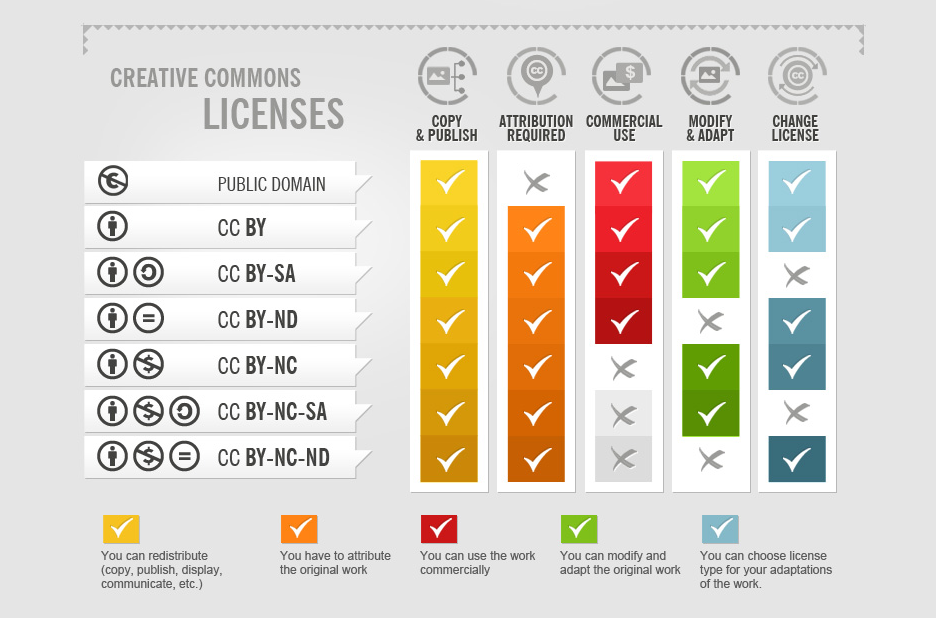
Creative Commons licenses by Foter (CC BY-SA 4.0)
The six categories of licenses offered are:
- Attribution – lets others distribute, remix, tweak and build upon work, even commercially, as long as they credit the creator.
- Attribution-NoDerivs – allows for commercial and non-commercial redistribution, as long as the work is passed along unchanged and in whole, crediting the creator.
- Attribution-NonCommercial-ShareAlike – lets others remix, tweak, and build upon work for non-commercial purposes, as long as they credit the creator and license any new creations under the identical terms.
- Attribution-ShareAlike – lets others remix, tweak, and build upon work for commercial and non-commercial purposes, as long as they credit the creator and license new creations under the identical terms.
- Attribution-NonCommercial – lets others remix, tweak, and build upon work for non-commercial purposes, crediting the creator. Derivative works do not have to be licensed under the same terms.
- Attribution-NonCommercial-NoDerivs – allows others to download work and share it as long as they credit the creator, but they can’t change them in any way or use it commercially.
Now that you know the difference between the licenses we can start looking for some great images.
Where Can I Find Creative Commons Images?
There are lots of good free stock photo sites out there but the following specialize in Creative Commons images.
Openverse
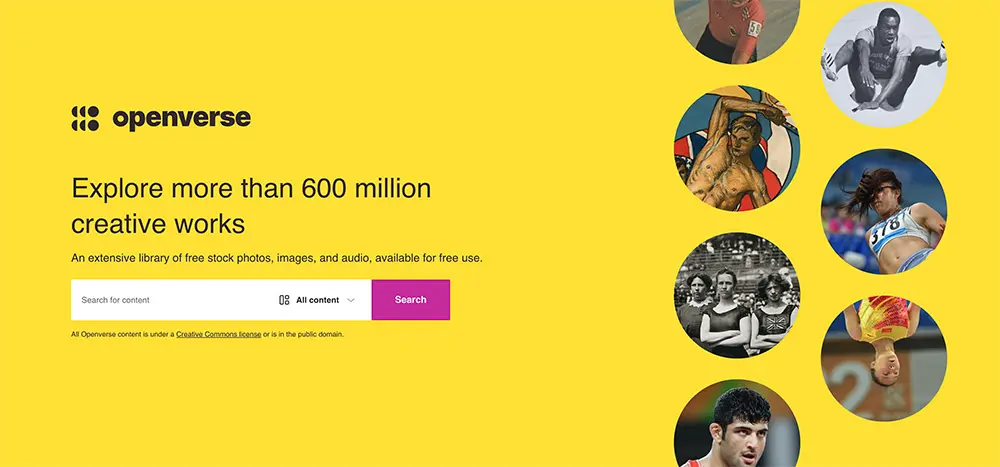
Openverse, formerly CC Search – the official Creative Commons search engine, became part of WordPress in 2021. It boasts over 600 million Creative Commons licensed and public domain image and audio files.

You can filter your searches by use, license, and image type. When looking for one of the best selections of Creative Commons content, make Openverse your first stop.
Flickr

Flickr is the granddaddy of photo sharing sites. Focusing on user-submitted images, the quality ranges from amateur to professional and there are plenty to choose from, especially in niche categories. Not all the photos on Flickr are available under Creative Commons licenses, so make sure you check the info associated with each image (as mentioned above) before using. Flickr has a Creative Commons search option and and a handy filter by use feature.

Europeana
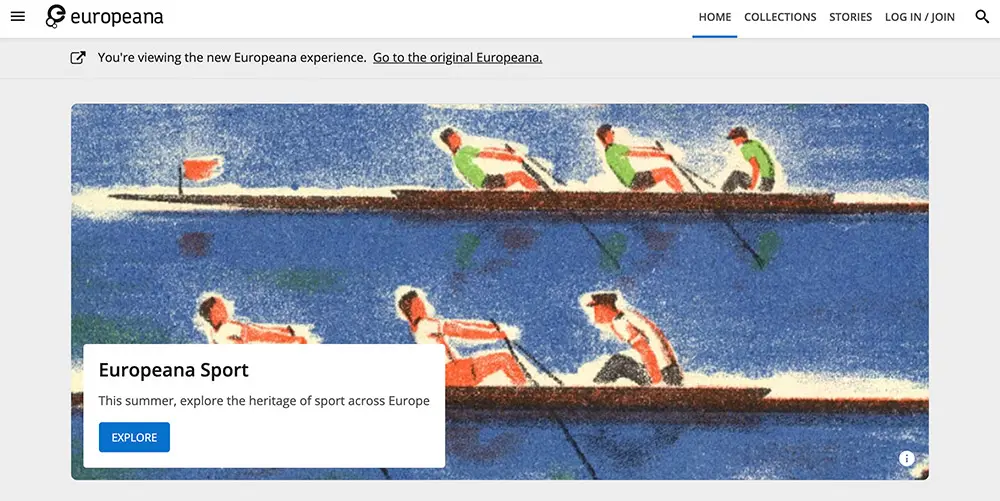
Europeana is a collection of images from European libraries, archives, and museums. I’m a fan of their natural language use-type search filter.
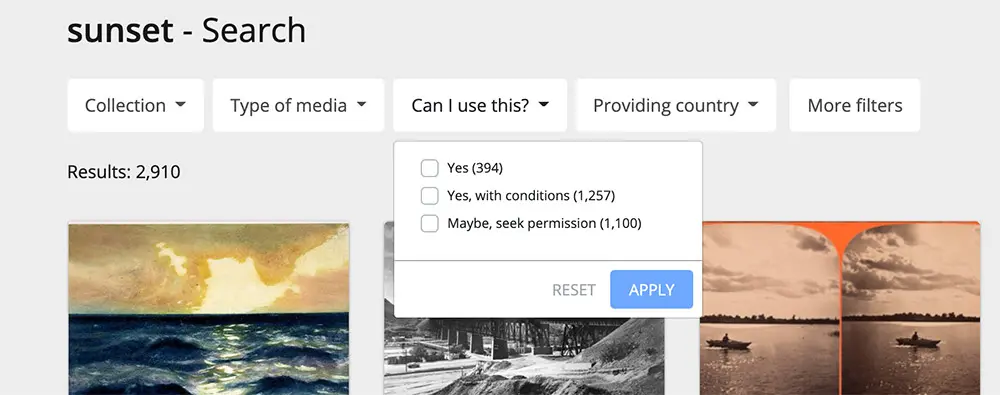
As you would expect with a site devoted mostly to artworks and documents, the selection is unique and may not fit every need. But it can be an excellent place to find one-of-a-kind photos for blog posts. This is a personal favorite of mine.
Wikimedia Commons

Wikimedia Commons is another of the early sites pioneering a collection of Creative Common works. Still going strong, it contains a staggering 74+ million freely usable media files. You can search by a range of categories including topic, location, license, and more. License information is displayed in multiple spots on the image detail pages.

How to Attribute Creative Commons Images
When using Creative Common images on your website or blog you’ll want to make sure to properly attribute them.
Where you include the attribution is up to you. Some people include the attribution in the photo caption while others place it at the end of the page or post.
Wherever you include it, the format of the attribution is important. You should include the following elements (known as the TASL model):
- Title: Title of the image
- Author: Name of the creator
- Source: URL where the image is hosted (A link to the author profile is optional).
- License: What type of Creative Commons license it is available under, including a link to the license.
Here’s an example using our main photo (sunset with the gorgeous palm trees):
Here She Comes, by Thomas Hawk licensed under CC BY 2.0
All that information should be readily available. I found that photo on Flickr and they conveniently gather it all under the image.

When in doubt look for the license symbols. Which brings us to…
Best Practices for Creative Commons Images
When using Creative Commons images, you are entering into an agreement with its creator, just as you do when you use other copyrighted images. A purchased stock photo usually has restrictions as to where and how it can be used. Creative Common licenses are no different in that regard.
Always check the license and terms before using a Creative Commons work. Follow the attribution guidelines. If you can’t find the creator or terms of use for the image, don’t use it.
Remember, this is someone’s creation and intellectual property. Don’t take advantage of the system. Help support this incredible library of creative works.
A Note About Using Google Image Search
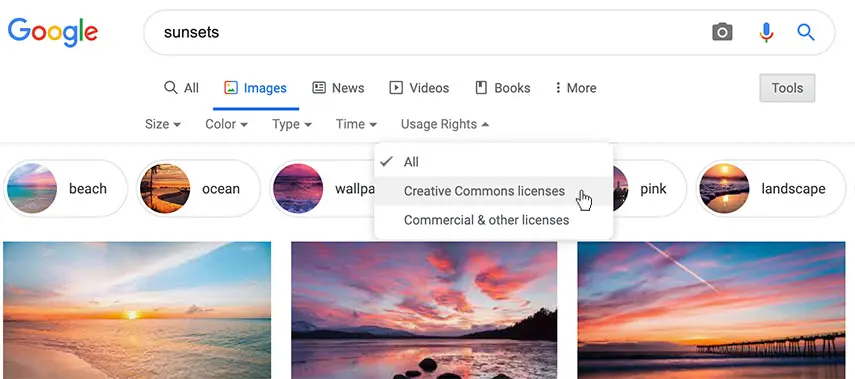
Google Image Search offers a filter for Creative Commons searches but it’s not a guarantee the results are actually licensed as such. Make sure to double check any images you find this way. Better yet, use one of the sites mentioned above with vetted Creative Commons collections.
Summary
Creative Commons is your key to a world of free creative works available to use for virtually all your projects. By performing some simple due diligence and following the terms of use for each license, you can use these photos, videos, audio files, and other works with confidence. In addition, your participation in the use of Creative Commons ensures the future of this valuable free resource.
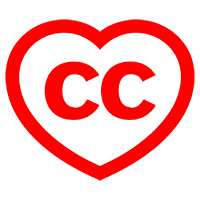
Main Image: Here She Comes, by Thomas Hawk licensed under CC BY 2.0.
